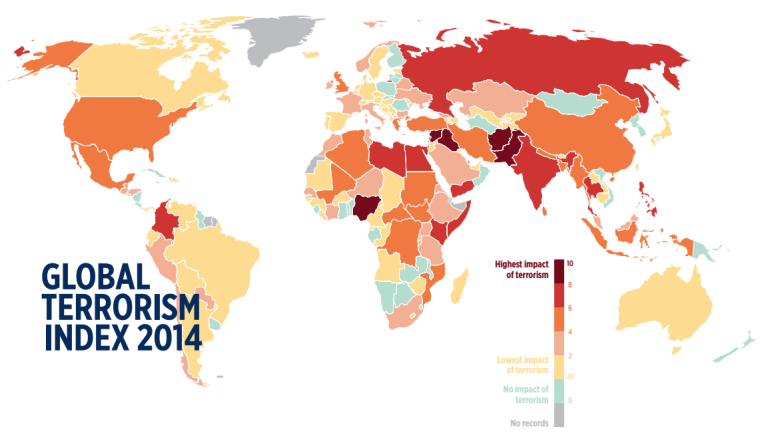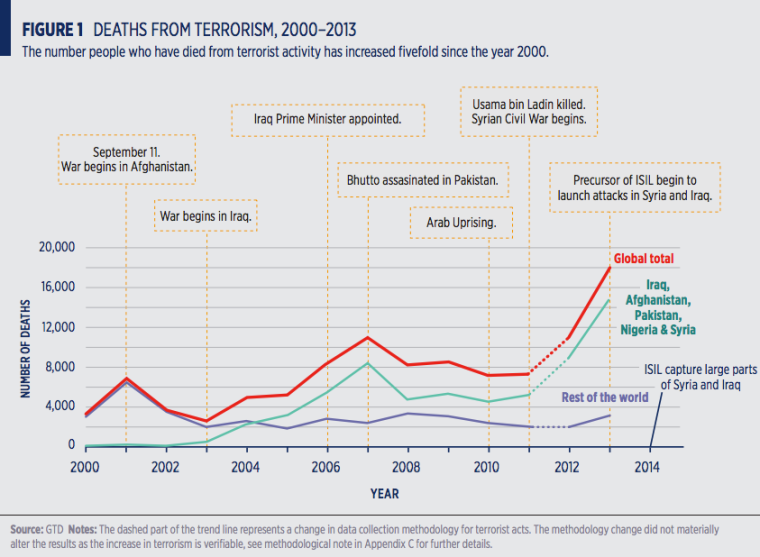ETA: Here’s the newer Global Terrorism Index from 2016.
In the wake of this week’s Charlie Hebdo tragedy in France and Boko Haram attack in northeastern Nigeria, a lot of rhetoric has been floating around the internet regarding the nature of Islam and its relationship to extremism and terrorism. Research has long been gathered related to terrorism and its motivations, so facts are readily available that can help to contextualize the discussion. Unfortunately, they mostly go ignored in the interest of promoting one ideological position or another.
Most of the following comes from the Institute for Economics and Peace’s 2014 Global Terrorism Index. Important insights from this report include (1) key trends, (2) correlates of terrorism, and (3) successful strategies for ending terrorism. In this post I’d like to share some of these facts and some ways we can contribute to more constructive discourse on the problem.
Terms
Defining terms is a critical (and contested) aspect of the categories utilized in the report, so following is the definition of “terrorism” used:
The GTI . . . defines terrorism as ‘the threatened or actual use of illegal force and violence by a non-state actor to attain a political, economic, religious, or social goal through fear, coercion, or intimidation.’ This definition recognises that terrorism is not only the physical act of an attack, but also the psychological impact it has on a society for many years after.
This is a somewhat broad definition, although some might quibble with the exclusion of state-sponsored violence. Using this definition, though, the GTI ranked the impact of terrorism within 162 countries:
Trends
As the report notes, there was a 61% increase in terrorist attacks from 2012 (11,133) to 2013 (17,958), and 2013’s attacks represent a fivefold increase from 2000 (3,361). Deaths occurred in 50% of terrorist attacks. More than 60% of the deaths attributable to these attacks occurred in one of five countries: Iraq, Afghanistan, Pakistan, Nigeria, and Syria. The following charts show various trends over the last 15 years:
This next graph shows how significant events influenced the rise and fall of deaths resulting from terrorist attacks:
The war in Iraq and the outbreak of the Syrian war coincide with the beginnings of the two largest spikes in terrorist activity. Religious-motivated terrorist activity increased significantly since 2002, when non-religious terrorism predominated. Outside of largely Islamic territories (Sub-Saharan Africa, the Middle East, and South Asia), political and ethnic/nationalist separatist terrorism predominates, as this chart illustrates:
In 2013 Islamic extremism did account for the majority of terrorist activity, but as the following chart shows, this is part of a recent and severe increase owing in large part to the rise of ISIL and Boko Haram:
Contributing Factors
You’ll note that comparison with figure 1 above shows the sharpest increase coincides with the beginning of the Syrian civil war. The Iraq War also coincides with an increase in activity. As the report finds, over 70% of terrorist activity occurs in areas experiencing major conflicts. Robert Pape argues that upwards of 90% of suicide terrorism is aimed specifically at uprooting occupying forces, a motivation that crosses the ideological boundaries that are drawn between the secular and the religious. The most prolific suicide bombers of the twentieth century, the Tamil Tigers, were ethnic separatists who appealed to Marxist ideology in their literature. The GTI highlights that, since 2000, 90% of suicide attacks have taken place in the Middle East and South Asia. This does not coincide with any change in the nature or function of Islam as a religion or an ideology, but is a function of the political/ethnic/social/economic dynamics at work in these areas. From the GTI:
From thousands of socio-economic, governance and attitudinal variables analysed, three groupings of indicators show a multivariate significant relationship with the GTI:
— Political stability
— Intergroup cohesion
— Legitimacy of the state
Areas where terrorist attacks are most frequent are areas where there is little political stability, where ethnic, religious, nationalist, and other groups experience conflict, and where the government lacks legitimacy. The fact that more than 70% of terrorism occurs in regions of major conflict suggests war is one of the predominant catalyst for terrorism in areas where those indicators are present.
Terrorism Outside Islamic Regions
Agencies in the United States and in the European Union have gathered a great deal of data regarding terrorism in their areas. For the EU, see the 2014 European Union Terror Situation and Trend Report. In the general overview it notes that 152 terrorist attacks were carried out in the EU in 2013, resulting in seven deaths. Two of those attacks are categorized by Europol as religiously inspired (resulting in one death). While religiously inspired attacks were quite low, there were 216 suspects arrested for planning or carrying out religiously inspired terrorist attacks. This marks an increase over the 159 arrests in the same category in 2012, and represents about 40% of the total 535 arrests for terrorist activities in 2013. This report from the FBI analyzes the 318 terrorist incidents, resulting in 3,178 deaths, that occurred in the US between 1980 and 2005. According to that report, Islamic extremism accounted for 6% of the attacks, just under the 7% attributed to Jewish extremism.
Mitigating Radicalization
A 2010 Duke University study available here analyzed the attitudes of Muslim-Americans toward extremism to attempt to account for the very low occurrence of radicalization taking place on American soil. It outlines several findings:
– There is increased anti-Muslim sentiment
– There is a low number of radicalized Muslim-Americans
– The practices of Muslim-American communities prevent radicalization
The following practices were identified as mitigating radicalization:
– Public and private denunciations of terrorism and violence
– Self-policing
– Community-building
– Political engagement
– Identity politics
The last practice requires some explanation. The report shows that Muslim-Americans have become more assertive of their Muslim identities since 9/11. While a great deal of rhetoric attempts to equate increased piety with an increased chance of radicalization, the report showed the opposite. Citing a 2007 Pew study (here), the Duke report noted that Muslim-Americans who said religion was “very important” in their lives were 1/3 less likely to respond that attacks on civilians were “sometimes” or “often justified” to defend Islam. When Muslim-Americans felt their identities as Americans were salient (increasingly common since 9/11), their communities were organized less frequently by ethnic group, and they felt a cultural connection to other Americans, reducing the occurrence of radicalization. The study states:
Over the past several decades, immigration and conversion have turned Muslim communities into far more multiethnic sites than the homogenous enclaves of a generation ago. According to a survey of more than 400 mosques in 2000, one third had no majority of participants from any single ethnic group. Immigrants from numerous countries come to know one another far more than they would have in their home countries, creating a new Islamic identity that is distinct from the narrower sense of ethnic identity.
It continues:
Today, many Islamic groups, including terrorist groups, claim to speak on behalf of the entire umma, the global community of Muslims. However, the pan-ethnic identity of Muslim-Americans serves to undermine terrorism by emphasizing the compatibility of Muslim-ness and American-ness. These are not two civilizations on a crash course, but instead two civilizations overlapping and melding.
Recommendations
The report concludes with the following recommendations for mitigating radicalization among Muslims:
1. Encourage politic mobilization. This is the most significant positive trend the report noted
2. Promote public denunciations of violence. Note: “promote,” not “demand.” The report points out that public opinion polls suggest Americans are woefully unaware of the “consistent and strong public denunciations following incidents here and abroad.”
3. Reinforce Self-Policing Efforts by Improving the Relationship Between Law Enforcement and Muslim-American Communities
4. Assist community-building efforts
5. Promote outreach by social service agencies. “This kind of engagement is viewed as an opportunity for Muslim-Americans to become stakeholders in the general community.”
6. Support enhanced religious literacy. A great example of this might be sharing the Letter to Baghdadi, an open letter recently published by a group of scholars of Islam denouncing terrorism and highlighting the many and various ways terrorism violates Islam and the Qur’an and has no legitimate basis in either.
7. Increase civil rights enforcement.Discrimination and contempt breeds bigotry and radicalization. ” Enhanced civil rights enforcement at local, state, and federal levels will contribute toward addressing Muslim-American concerns.”
Conclusion
Terrorism is too critical a problem to publicly engage with naive assumptions and empty rhetoric. Let’s get educated on the issues before we lose ourselves in rhetorical excesses and dogmatism.





January 17th, 2015 at 3:16 am
[…] “Terrorism is too critical a problem to publicly engage with naive assumptions and empty rheto… […]
May 19th, 2015 at 8:14 pm
Great post. Thanks for compiling and describing so much content.
May 22nd, 2017 at 5:46 pm
Trouble is quran promotes inequality and hatred of Jews xtians yazidis polytheists atheists. Islam worldwide is ideal. Islam is supremacist. With these facts in mind, any more ideas?
May 22nd, 2017 at 5:49 pm
Quran doesn’t promote anything. Readers will get out of it what their frameworks determine is needed.
https://danielomcclellan.wordpress.com/2015/08/26/on-the-myth-of-scriptural-literalism/
Christianity also promotes a supremacist ideology. There are still Christian terror groups in many places.